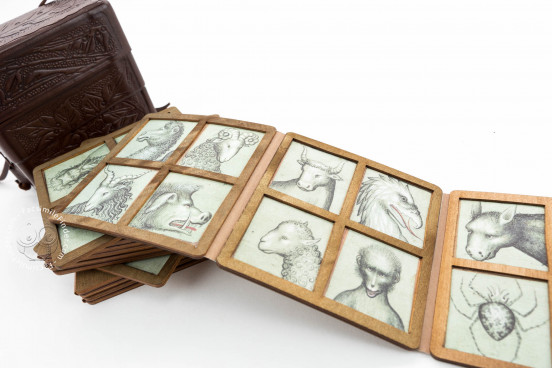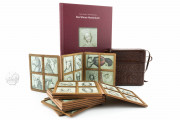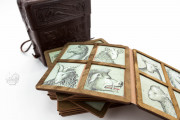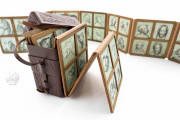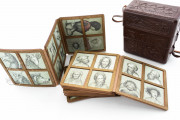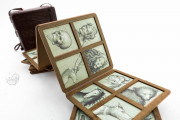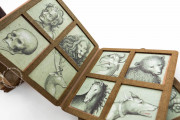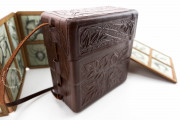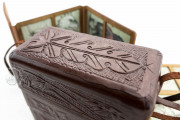Despite its name, the intended purpose of the Vienna Model Book remains a mystery. It was possibly designed to be carried around by its artist as a collection of work to show potential patrons. Made around 1410-1420 by a Bohemian artist, except for two later drawings, the object comprises fourteen maple panels gathered in a leather case with a strap. It is a collection of silverpoint drawings with touches of white and red, including thirty-nine human heads and seventeen heads of animals and mythical creatures.
The Kunsthistorisches Museum of Vienna, which is truly rich in magnificent works of art, also houses this unequalled masterpiece; an artistic treasure so unique in its kind and artistic form which remains, however, an utterly enigmatic object. This collection of paintings by an anonymous bohemian master comprises a total of 56 silver pen drawings.
Delicately heightened with colour, they bear testimony to his great skill and mastery. In this piece of work, the artist has perfectly implemented the rich formal vocabulary of the “International Style” from the period around 1400.
The extremely delicate drawings have additionally been modelled with fine brush strokes in white and red and thus attain outstanding three-dimensionality, despite their small format.
Acor Tablets and a Stamped Leather Case – A Precious Frame for a Magnificent Work of Art
This is a truly extraordinary piece, not least due to its outer appearance: a total of 14 small acorn tablets lie protected in a valuable, dark stamped leather case. Each of the tablets is set with four fine, detailed drawings that are placed in small frames.
The tablets were originally arranged in a fanfold, and the valuable leather case had been designed to protect the valuable contents, with a strap that probably served to carry it around as a bag. The purpose of this unique piece of art still remains a matter of speculation.
Was it a model collection for an itinerant artist, who was just as familiar with bohemian as with french and italian art, or was it destined for a patron – a gift of thanks or an incentive for the patron to commission more art in order to secure the artist’s livelihood?
Elaborate Portraits and Mythical Creatures
All 56 drawings show the entire brilliance of the artist, 39 present magnificent and extremely individualistic portraits reminiscent of the quality of Duerer (two of which have been added at a later stage, during the second quarter of the 15th century), 16 are depictions of animals and mythical creatures and an almost expressionist looking skull.
One particularly fascinating feature is the only full-length drawing of a spider which, like all the other depictions of this virtuoso artist, brilliantly emphasises the small pictorial motif against a totally alienating greenish-grey ground.
A wide array of different head types underlines the link with sacral/christian themes – such as Mary mother of God, the Angel of the Annunciation, the Infant Christ, the Crucified or the Apostles – and the profane world of the court.
Between all the spaceless heads and busts the viewer discerns a charming young boy looking into a water basin: it must be Narcissus who due to the beauty of his own reflection was definitely a widely used motif in 15th-century painting.
The whole universe of the outstanding “soft style” had been especially designed to evoke astonishment amongst viewers and to promote the skills of their creator – today just as well as 600 years ago.
The Vienna Model Book is a late testimony to what is now commonly referred to as the King Wenceslas school, and in this capacity it is the sum of what bohemian art has brought forth since the period of Emperor Charles IV and Peter Parler. At the same time it constitutes a link to later paintings of the 15th century.
A Medieval Artist and Illuminator
Delicate miniatures of unsurpassed quality were made from around 1410 to 1420 in Bohemia and Austria. The drawings perhaps served as a model collection for an itinerant artist.
The depictions of 56 heads, bust portraits as well as animals and mythical creatures show Bohemian, French and Italian influences, providing a valuable example of the immensely rich and elaborate “International Style”.
We have 1 facsimile edition of the manuscript "Vienna Model Book": Wiener Musterbuch facsimile edition, published by Mueller & Schindler, 2012
Request Info / Price
